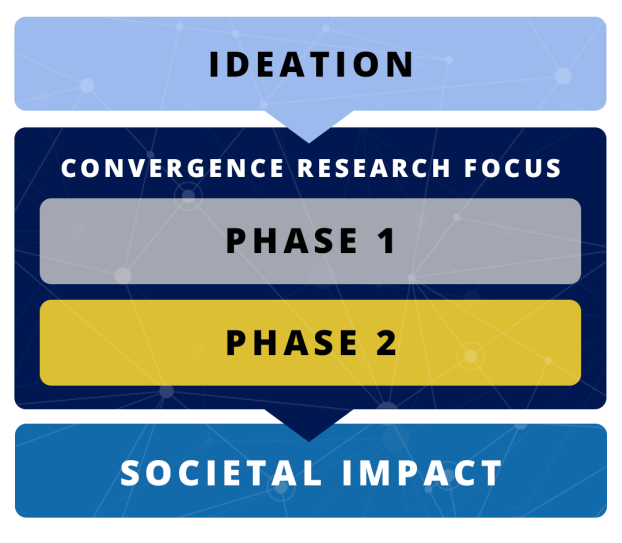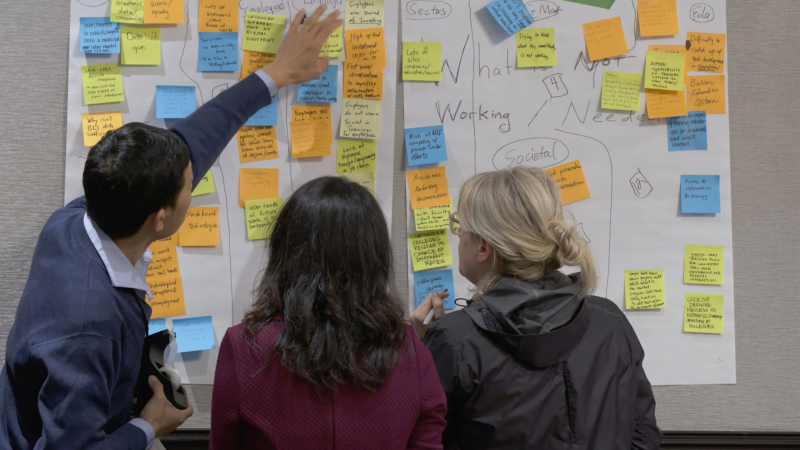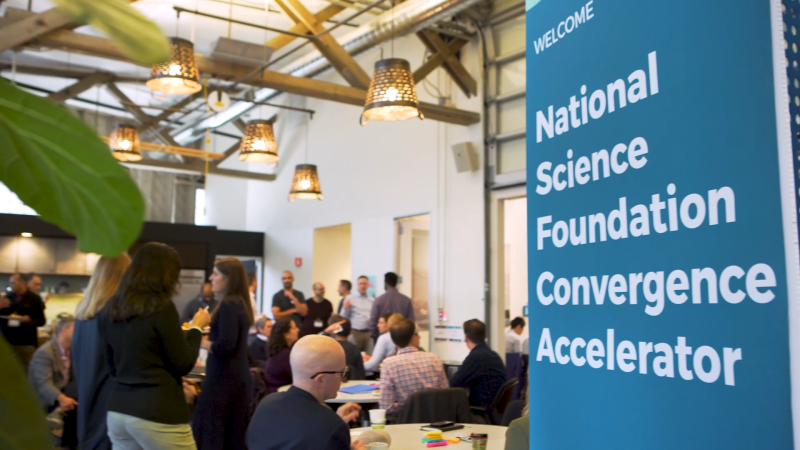The Convergence Accelerator program model includes three phases: topic identification and convergence research phases 1 and 2. Teams that complete the convergence research phases are expected to deliver high-impact solutions that meet societal needs and continue to have an impact after NSF support ends.

Credit: National Science Foundation
Ideation process: Topic identification
Convergence Accelerator research topics begin in the ideation process. Ideas from the community are gathered through a Dear Colleague Letter, Request for Information, DCL/RFI.
Submitted topic ideas must fulfill all the following requirements:
- Be broad in technical scope.
- Be impactful to society at scale.
- Build upon foundational research.
- Be suitable for a multidisciplinary, convergent research approach.
Furthering the idea
Ideas that meet the program’s criteria are funded by NSF into community workshops. Workshops are intended to further develop and frame ideas to incorporate convergence research and encourage collaboration among stakeholders from various disciplines and with different forms of expertise from academic, industry, nonprofit, government, and other communities of practice. The findings of these workshops assist NSF in developing the final convergence research track topics to be funded for the next year.
Convergence research
The Convergence Accelerator speeds use-inspired research into practice through a two-phase process. The program releases a solicitation featuring research track topics each year. Topics aligned to a specific research focus are called "tracks" and funded teams within the tracks make up a cohort. All teams within a cohort begin in Convergence Research phase 1.
At the end of phase 1, the teams participate in a formal NSF pitch and proposal process, which is used in selecting teams for phase 2. Teams selected for phase 2 will continue accelerating their solutions toward impact. By the end of the Convergence Research phases, solutions are expected to impact societal needs at scale and be sustainable beyond NSF support.
Phase 1: Team convergence and proof-of-concept development
- Participate in an accelerated nine-month planning effort, with grant funding of up to $750,000.
- Apply a multidisciplinary approach to develop each initial idea into a proof of concept and to identify new team members and partners.
- Learn and apply the Convergence Accelerator fundamentals through a hands-on innovation curriculum, which includes human-centered design, team science, communications, storytelling and pitching.
- Work in a "coopetition" environment — competing while also sharing expertise and resources — to stimulate ideas and identify needed skills, expertise and partnerships to accelerate each solution forward.
At the end of phase 1, teams participate in a formal NSF pitch and proposal evaluation. Selected teams advance to phase 2.
Phase 2: Prototyping and sustainability planning
Phase 2 focuses on developing sustainable and impactful project deliverables. Phase 2 teams:
- Continue solution development through a two-year effort, with cooperative agreement funding of up to $5 million.
- Continue to apply phase 1 fundamentals and participate in an entrepreneurial curriculum that includes product development, intellectual property, financial resources, sustainability planning, and communications and outreach.
By the end of phase 2, teams are expected to provide deliverables that impact societal needs at scale and are sustainable beyond NSF support.
Curriculum
Each convergent research phase includes a curriculum designed to strengthen collaboration, foster partnerships and transform basic research into high-impact solutions.
The innovation curriculum is designed to assist teams in advancing their initial idea to a proof of concept. The curriculum includes:
- User discovery: Identifying end users to provide problem validation, insights and feedback on prototypes.
- Human-centered design: Engaging with end users, including how to develop a low-fidelity prototype for testing.
- Team science: Unifying a diverse team to develop a vision and focus on common goals.
- Communication: Increasing the impact of team ideas by engaging, listening to and accepting feedback from partners and other stakeholders.
- Coaching and mentorship: Guidance is provided to assist the team's mastery of the curriculum, enhancing the team's understanding of entrepreneurship and accelerating their idea into reality.
- Pitching: Conveying the project's value by describing the challenge and solution through storytelling and communication to various stakeholders including potential partners, investors and end users. Throughout the curriculum, teams practice pitching, with the formal pitch occurring at the end of phase 1.
- Public expo: The Convergence Accelerator hosts its annual expo to showcase the program's project portfolio to the public, potential investors and other stakeholders. Teams demonstrate their solutions and have the opportunity to develop new partnerships.
The idea-to-market curriculum is designed to unleash an entrepreneurial mindset and skill set and to ensure each funded project reaches its full potential. The curriculum includes:
- Coaching and mentorship: Mentorship continues and is closely coordinated to each team’s needs.
- Pitching: Skills are continued to be practiced.
- Sustainability: Developing a sustainability plan to ensure a solution’s highest impact.
- Product mindset: Skills are provided to support solution refinement.
- Other entrepreneurial skills: Financial pathways and resources are provided to assist teams in advancing their solution into practical application.
- Public expo: The Convergence Accelerator hosts its annual expo to showcase the program's project portfolio to the public, potential investors and other stakeholders. Teams demonstrate their solutions and have the opportunity to develop new partnerships.


